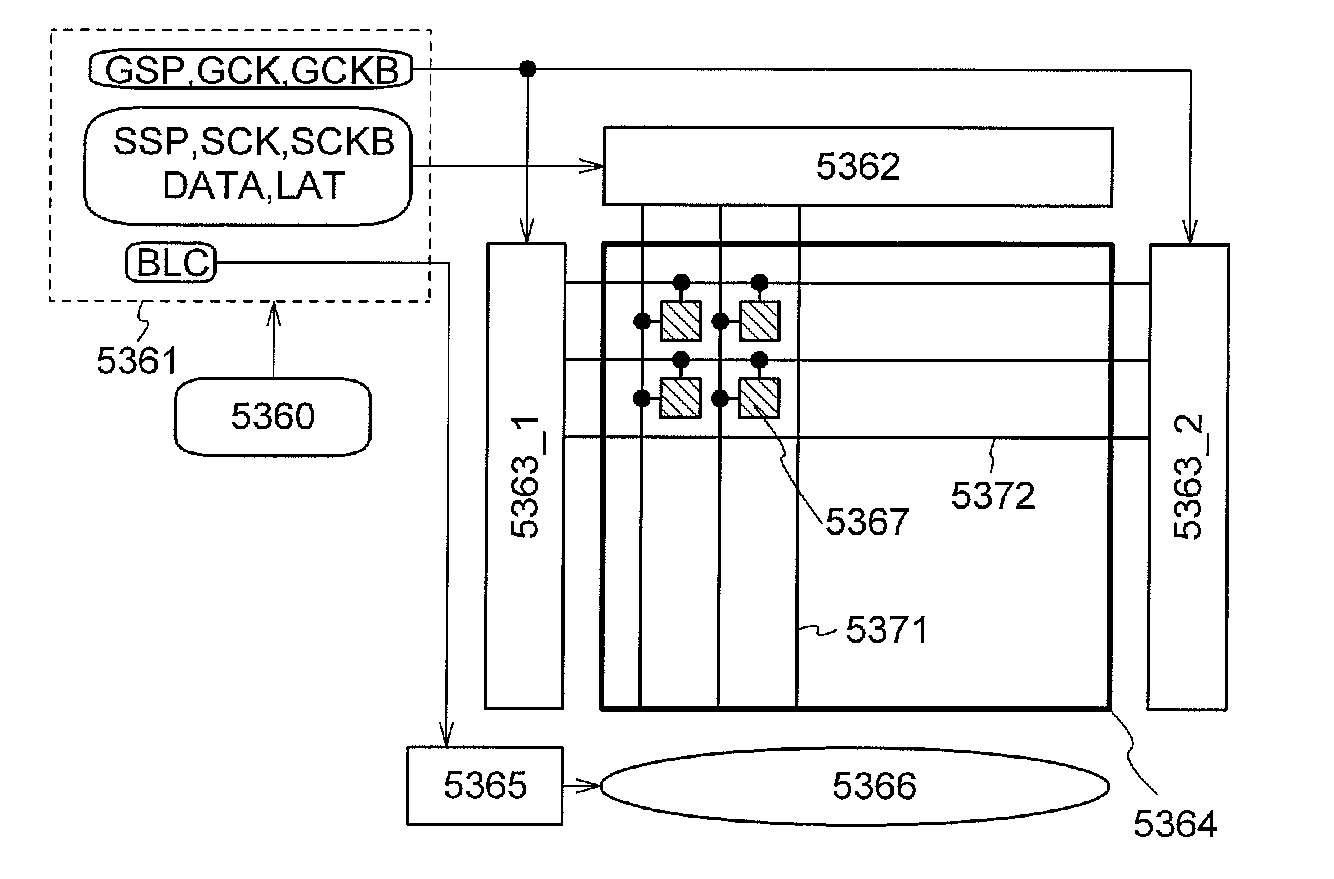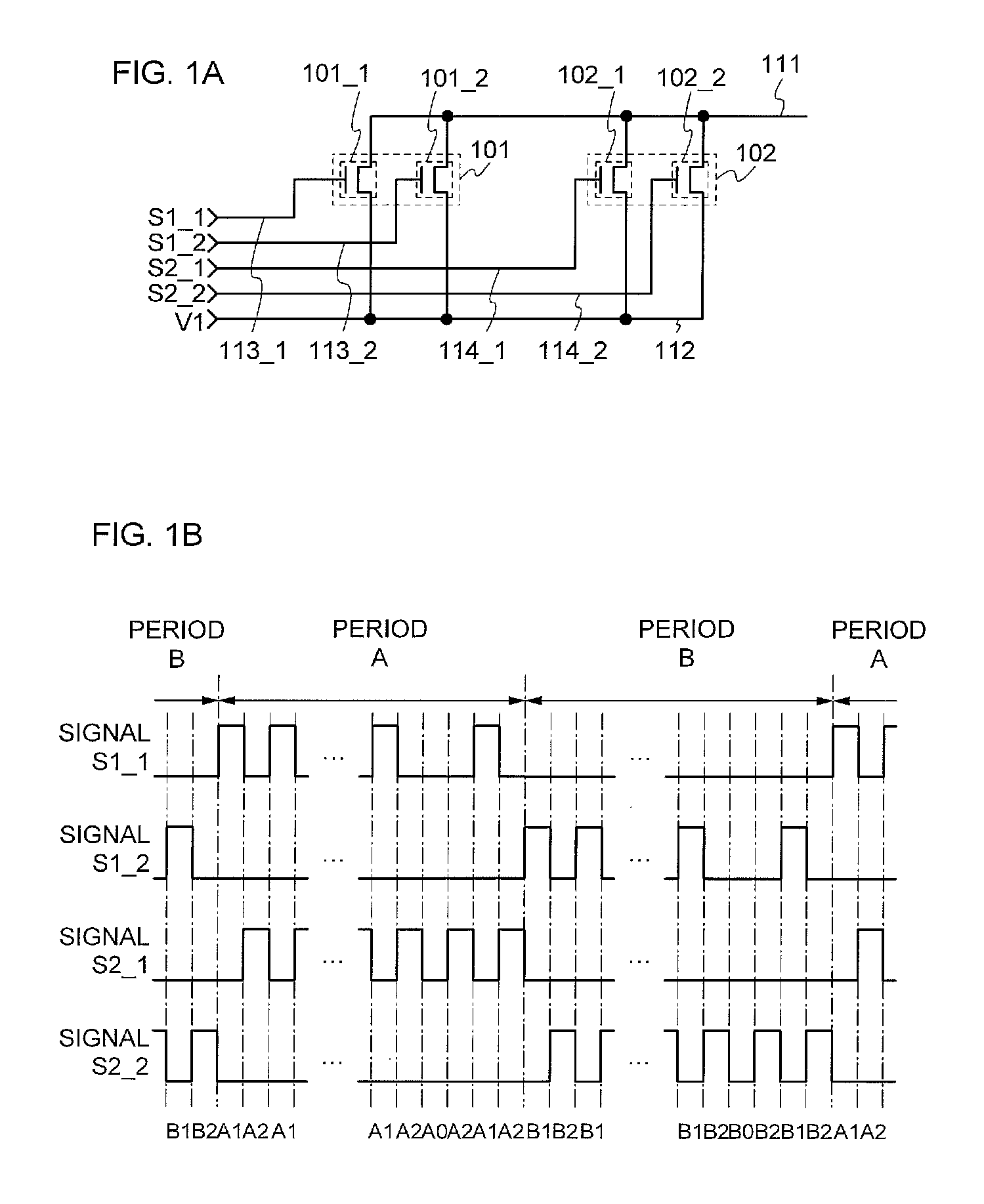Method for driving display device
- Summary
- Abstract
- Description
- Claims
- Application Information
AI Technical Summary
Benefits of technology
Problems solved by technology
Method used
Image
Examples
embodiment 1
[0112]In this embodiment, an example of a semiconductor device will be described. The semiconductor device in this embodiment can be used for, for example, a shift register, a gate driver, a source driver, or a display device. Note that the semiconductor device in this embodiment can also be referred to as a driver circuit.
[0113]First, a basic circuit which can be used for the semiconductor device in this embodiment is described with reference to FIG. 41A. The circuit in FIG. 41A includes a plurality of circuits: a circuit 101 and a circuit 102. The circuit 101 includes a plurality of switches: a switch 11_1 and a switch 112. The circuit 102 includes a plurality of switches: a switch 12_1 and a switch 12_2. The switches 11_1, 11_2, 12_1, and 122 are connected between a wiring 111 and a wiring 112. Note that the circuit in FIG. 41A can also be referred to as a semiconductor device or a driver circuit.
[0114]The switches 11_1, 11_2, 12_1, and 12_2 have a function of controlling a condu...
embodiment 2
[0198]In this embodiment, an example of a semiconductor device will be described. The semiconductor device in this embodiment can include the semiconductor device in Embodiment 1. The semiconductor device in this embodiment can be used for, for example, a flip flop, a shift register, a gate driver, a source driver, or a display device. Note that the semiconductor device in this embodiment can also be referred to as a flip flop or a driver circuit.
[0199]First, an example of the semiconductor device in this embodiment is described with reference to FIG. 7A. The semiconductor device in FIG. 7A includes the circuit 101, the circuit 102, and a transistor 201. The circuit 101 includes a plurality of transistors: the transistor 101_1 and the transistor 1012. The circuit 102 includes a plurality of transistors: the transistor 102_1 and the transistor 102_2.
[0200]Note that the transistor 201 preferably has the same polarity as the transistors 101_1, 101_2, 102_1, and 102_2, and is often an n...
embodiment 3
[0254]In this embodiment, an example of the circuit 300 described in Embodiment 2 will be described. Note that the circuit 300 can be referred to as a semiconductor device, a driver circuit, or a gate driver. The contents described in Embodiments 1 and 2 are not repeated. Further, the contents described in Embodiments 1 and 2 can be freely combined with a content described in this embodiment.
[0255]First, an example of the circuit 300 is described with reference to FIG. 21A. The circuit 300 includes a transistor 301, a transistor 302, a transistor 303, a transistor 304_1, a transistor 304_2, a transistor 305_1, and a transistor 305_2. Note that this embodiment is not limited thereto, and the circuit 300 can include a variety of other components. Alternatively, any of the transistors in the circuit 300 can be omitted.
[0256]Note that the transistors 301, 302, 303, 304_1, 304_2, 305_1, and 305_2 preferably have the same polarity as the transistor 201, and are n-channel transistors. Note...
PUM
 Login to View More
Login to View More Abstract
Description
Claims
Application Information
 Login to View More
Login to View More - R&D
- Intellectual Property
- Life Sciences
- Materials
- Tech Scout
- Unparalleled Data Quality
- Higher Quality Content
- 60% Fewer Hallucinations
Browse by: Latest US Patents, China's latest patents, Technical Efficacy Thesaurus, Application Domain, Technology Topic, Popular Technical Reports.
© 2025 PatSnap. All rights reserved.Legal|Privacy policy|Modern Slavery Act Transparency Statement|Sitemap|About US| Contact US: help@patsnap.com



